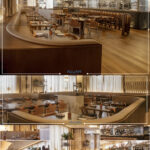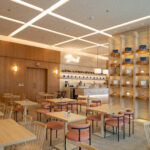Introduction
Importance of Safety in Office Design
Designing safe office fitouts is paramount for the well-being of employees and the efficiency of business operations. Safety in office design not only prevents accidents and injuries but also promotes a sense of security and comfort, which can enhance productivity and job satisfaction. An office that prioritizes safety fosters a positive work culture and can significantly reduce workplace-related stress and absenteeism.
Relevance of Safe Office Fitouts in Modern Workplaces
In today’s dynamic work environments, where flexible and remote working arrangements are becoming more common, the importance of safe office fitouts cannot be overstated. Modern workplaces need to adapt to various health and safety regulations while accommodating the diverse needs of their workforce. Safe office design is integral to creating inclusive and productive spaces that cater to all employees, regardless of their physical abilities.
Key Principles of Safe Office Design
Importance of Ergonomics
Ergonomics plays a critical role in office safety by designing workplaces that fit the physical needs of employees. Proper ergonomic practices help reduce the risk of musculoskeletal disorders, enhance comfort, and improve overall productivity. Ergonomic design considers the interaction between workers and their environment, aiming to optimize well-being and performance.
Ergonomic Furniture
Investing in ergonomic furniture is essential for a safe office. Chairs with adjustable height and lumbar support, desks that can accommodate sitting and standing positions, and ergonomic keyboards and mice can significantly reduce physical strain. These pieces of furniture support natural body posture, minimizing the risk of repetitive strain injuries.
Workstation Setup
An ergonomic workstation setup involves positioning equipment to avoid unnecessary strain. Monitors should be at eye level, keyboards and mice within easy reach, and chairs adjusted so that feet rest flat on the floor. Providing guidelines and training on proper workstation setup can further enhance ergonomic safety.
Prevention of Repetitive Strain Injuries
Repetitive strain injuries (RSIs) are common in office settings due to repetitive tasks like typing. To prevent RSIs, encourage regular breaks, provide ergonomic tools, and ensure that tasks vary to reduce repetitive motion. Stretching exercises and ergonomic assessments can also help in mitigating these risks.
Ergonomic Accessories
Accessories like wrist supports, footrests, and monitor stands can enhance ergonomic comfort. These tools help maintain natural body alignment and reduce strain on specific body parts, contributing to a safer and more comfortable working environment.
Accessibility
Compliance with ADA Standards
Ensuring accessibility in office design involves complying with the Americans with Disabilities Act (ADA) standards. This includes providing accessible entrances, pathways, and facilities for employees with disabilities. Compliance not only meets legal requirements but also promotes inclusivity.
Design for Differently-abled Employees
Designing for differently-abled employees involves creating adaptable workspaces. Adjustable desks, accessible restrooms, and clear signage are essential. Incorporating assistive technologies and ensuring barrier-free movement throughout the office are also critical for accessibility.
Universal Design Principles
Universal design principles advocate for creating environments that are usable by all people, to the greatest extent possible, without the need for adaptation. This approach benefits everyone, including those with disabilities, by promoting equal access and usability.
Accessible Workstations
Accessible workstations should be adjustable and equipped with the necessary tools to accommodate employees with varying needs. Features like adjustable height desks, accessible storage, and ergonomic chairs ensure that all employees can work comfortably and safely.
Navigating Office Spaces
Clear and wide pathways, appropriate signage, and accessible emergency exits are crucial for safe navigation in office spaces. Ensuring that office layouts are intuitive and free from obstructions enhances safety and accessibility for everyone.
Fire Safety
Fire Safety Regulations
Adhering to fire safety regulations is mandatory for office fitouts. These regulations include requirements for fire-resistant materials, emergency exits, fire alarms, and sprinkler systems. Compliance ensures that the office is prepared to handle fire emergencies effectively.
Fire-resistant Materials
Using fire-resistant materials in office construction can prevent the rapid spread of fire and provide additional time for evacuation. Materials such as fire-rated doors, walls, and ceilings are critical in enhancing fire safety in the workplace.
Emergency Exits and Signage
Clearly marked and easily accessible emergency exits are essential for fire safety. Exit signs should be illuminated and visible from all parts of the office. Regular drills and clear evacuation plans ensure that employees are familiar with exit routes and procedures.
Fire Alarms and Sprinklers
Installing and maintaining fire alarms and sprinkler systems are crucial components of office fire safety. These systems provide early warning and can help control fires before they become unmanageable. Regular testing and maintenance are essential to ensure their effectiveness.
Evacuation Plans
Developing and communicating clear evacuation plans is vital for ensuring safety during fire emergencies. These plans should include designated assembly points, roles and responsibilities, and procedures for assisting individuals with disabilities. Regular drills reinforce these plans and ensure readiness.
Electrical Safety
Proper Wiring and Cables Management
Proper wiring and cable management prevent electrical hazards such as short circuits and fires. Cables should be organized, secured, and away from high-traffic areas to avoid damage and tripping hazards. Regular inspections ensure that all electrical systems are in good condition.
Surge Protection
Surge protectors safeguard office equipment from voltage spikes, which can damage electronics and pose fire risks. Installing surge protection devices and educating employees on their use are essential steps in maintaining electrical safety.
Safe Use of Electrical Equipment
Ensuring that electrical equipment is used safely involves regular maintenance, proper training, and adherence to manufacturer guidelines. Employees should be aware of the potential risks and the importance of reporting faulty equipment immediately.
Regular Electrical Inspections
Regular electrical inspections by qualified professionals can identify and address potential hazards before they cause harm. Inspections should include checks on wiring, outlets, and equipment to ensure everything is functioning safely and efficiently.
Addressing Overloading Concerns
Overloading electrical outlets and circuits can lead to overheating and fires. Offices should have adequate power outlets and circuits to support all necessary equipment, and employees should be educated on the risks of overloading.
Lighting
Importance of Adequate Lighting
Adequate lighting is crucial for safety and productivity in the office. Poor lighting can lead to eye strain, headaches, and accidents. Properly lit workspaces improve visibility and create a comfortable working environment.
Types of Lighting
Different types of lighting, including ambient, task, and accent lighting, serve various purposes in the office. Ambient lighting
provides overall illumination, task lighting focuses on specific work areas, and accent lighting enhances aesthetic appeal.
Natural vs. Artificial Lighting
Natural lighting has numerous benefits, including improved mood and energy levels. Offices should maximize natural light through windows and skylights. However, artificial lighting is necessary to ensure consistent illumination, especially in areas with limited natural light.
Lighting for Different Work Areas
Different office areas require different lighting solutions. For example, workstations need bright, focused lighting, while break rooms benefit from softer, ambient light. Tailoring lighting to specific areas enhances both safety and functionality.
Impact of Lighting on Productivity
Proper lighting significantly impacts productivity. Bright, well-distributed lighting reduces eye strain and fatigue, allowing employees to work more comfortably and efficiently. Adjustable lighting solutions can cater to individual preferences and needs.
Ventilation and Air Quality
Importance of Good Air Quality
Good air quality is essential for health and productivity. Poor air quality can cause respiratory problems, allergies, and decreased cognitive function. Ensuring clean, fresh air in the office promotes a healthier and more comfortable work environment.
Ventilation Systems
Effective ventilation systems circulate fresh air and remove indoor pollutants. Offices should have systems that provide adequate ventilation and filtration to maintain air quality. Regular maintenance of these systems ensures their effectiveness.
Managing Indoor Pollutants
Indoor pollutants, such as dust, chemicals, and mold, can adversely affect air quality. Using low-emission materials, maintaining cleanliness, and controlling humidity levels help manage and reduce these pollutants.
Plants for Air Quality Improvement
Indoor plants can improve air quality by absorbing pollutants and increasing oxygen levels. Incorporating plants into office design not only enhances aesthetics but also contributes to a healthier environment.
Regular Maintenance of Ventilation Systems
Regular maintenance of ventilation systems is crucial to ensure they function effectively. This includes cleaning filters, checking for leaks, and ensuring that all components are operating efficiently. A well-maintained system provides consistent air quality.
Designing for Different Office Areas
Reception Area Safety
The reception area is the first point of contact and should be designed for both safety and accessibility. Clear signage, non-slip flooring, and adequate lighting are essential. Additionally, having a well-organized reception desk ensures that visitors and employees can navigate the area safely.
Safe Conference Rooms
Conference rooms should be equipped with ergonomic furniture, proper lighting, and adequate ventilation. Ensuring that electrical equipment is safely installed and providing clear exit routes are also critical for safety.
Safe Workstations
Workstations should be designed with ergonomics, lighting, and accessibility in mind. Proper organization and regular maintenance help prevent hazards and ensure a safe working environment.
Break Room Safety
Break rooms should be safe and comfortable, with non-slip flooring, clean and well-maintained appliances, and proper waste disposal facilities. Ensuring that these areas are free from hazards promotes a safe and relaxing environment for employees.
Restroom Safety
Restrooms should be accessible, clean, and equipped with non-slip flooring. Regular maintenance ensures that fixtures are in good working order, and clear signage helps prevent accidents.
Common Safety Challenges and Solutions
Managing Clutter
Clutter can create safety hazards by obstructing pathways and workspaces. Implementing regular cleaning schedules, providing adequate storage solutions, and encouraging organizational practices can effectively manage clutter.
Addressing Slips, Trips, and Falls
Slips, trips, and falls are common office hazards. Non-slip flooring, proper lighting, and regular maintenance of walkways help prevent these accidents. Additionally, educating employees about the importance of keeping walkways clear can further reduce risks.
Handling Hazardous Materials
Proper storage and handling of hazardous materials, such as cleaning chemicals, are essential for office safety. Providing appropriate training and safety equipment ensures that these materials are used safely and responsibly.
Safe Storage Solutions
Adequate storage solutions prevent accidents and improve organization. Shelving, cabinets, and storage units should be easily accessible and sturdy, reducing the risk of items falling or causing obstruction.
Maintenance and Repairs
Regular maintenance and timely repairs are crucial for maintaining a safe office environment. Addressing issues such as faulty wiring, broken furniture, and damaged flooring promptly prevents accidents and ensures the office remains safe and functional.
Future Trends in Office Safety Design
Smart Office Technologies
Smart technologies, including IoT devices and automated systems, are revolutionizing office safety. These technologies provide real-time monitoring and control, enhancing safety measures and response times.
Sustainable Safety Solutions
Sustainable materials and practices are becoming integral to office safety design. Eco-friendly solutions not only reduce environmental impact but also improve indoor air quality and overall health.
Trends in Ergonomic Design
Advancements in ergonomic design continue to improve workplace safety and comfort. Emerging trends focus on adaptable and customizable furniture that caters to individual needs and promotes well-being.
Impact of Remote Work on Office Safety
The rise of remote work has changed office safety dynamics. Ensuring that home offices are ergonomically designed and providing resources for safe remote work practices are essential for overall safety.
Predictive Safety Technologies
Predictive technologies, such as AI and machine learning, are being used to anticipate and mitigate safety risks. These technologies analyze data to predict potential hazards and suggest preventive measures.
Expert Opinions
Insights from Safety Consultants
Safety consultants provide valuable insights into best practices for designing safe office environments. Their expertise helps identify potential risks and implement effective safety measures.
Quotes from Ergonomics Experts
Ergonomics experts emphasize the importance of designing workspaces that promote physical well-being. Their advice on ergonomic practices and furniture selection enhances office safety.
Fire Safety Engineers’ Perspectives
Fire safety engineers offer guidance on implementing fire safety measures, including the use of fire-resistant materials and effective evacuation plans. Their expertise ensures comprehensive fire safety.
Electrical Safety Specialists’ Advice
Electrical safety specialists provide recommendations on proper wiring, equipment use, and regular inspections. Their insights help prevent electrical hazards and ensure a safe working environment.
Ventilation Experts’ Recommendations
Ventilation experts highlight the importance of good air quality and effective ventilation systems. Their advice on maintaining and improving air quality contributes to a healthier office environment.
Resources for Further Learning
Books on Office Safety Design
Books on office safety design provide in-depth knowledge and practical tips for creating safe work environments. These resources cover various aspects of safety, from ergonomics to fire safety.
Online Courses and Webinars
Online courses and webinars offer convenient ways to learn about office safety design. These programs provide up-to-date information and training on best practices and new developments in the field.
Safety Design Certifications
Obtaining certifications in safety design demonstrates expertise and commitment to maintaining safe work environments. These certifications cover various safety aspects and are recognized by professional organizations.
Websites and Blogs
Websites and blogs dedicated to office safety design offer valuable insights, tips, and updates. These resources provide ongoing education and keep professionals informed about the latest trends and practices.
Professional Organizations and Forums
Joining professional organizations and participating in forums allows for networking and knowledge sharing. These communities provide support and resources for professionals dedicated to office safety design.
Conclusion
Designing for safety is essential for creating a productive and healthy office environment. By prioritizing ergonomics, accessibility, fire safety, electrical safety, lighting, and ventilation, offices can ensure the well-being of their employees. Office safety design is an ongoing process that requires regular review and improvement. Staying informed about new trends, technologies, and best practices is crucial for maintaining a safe workplace. Office managers and designers play a vital role in ensuring workplace safety. By implementing the principles and practices outlined in this guide, they can create safer and more efficient office environments.






